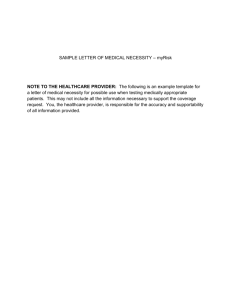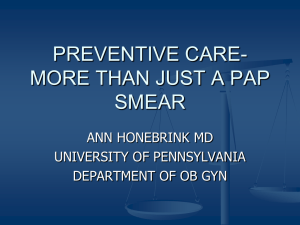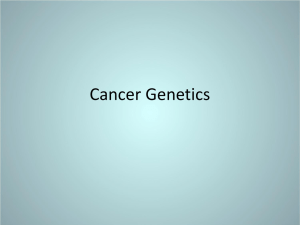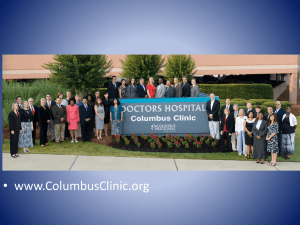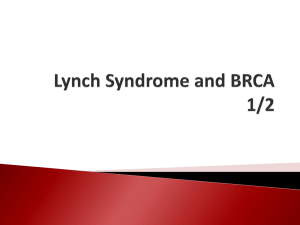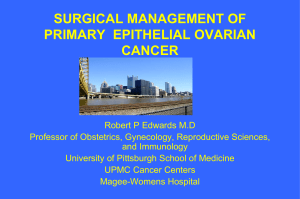Hereditary Breast/Ovarian Cancer Syndromes: Clinical Management
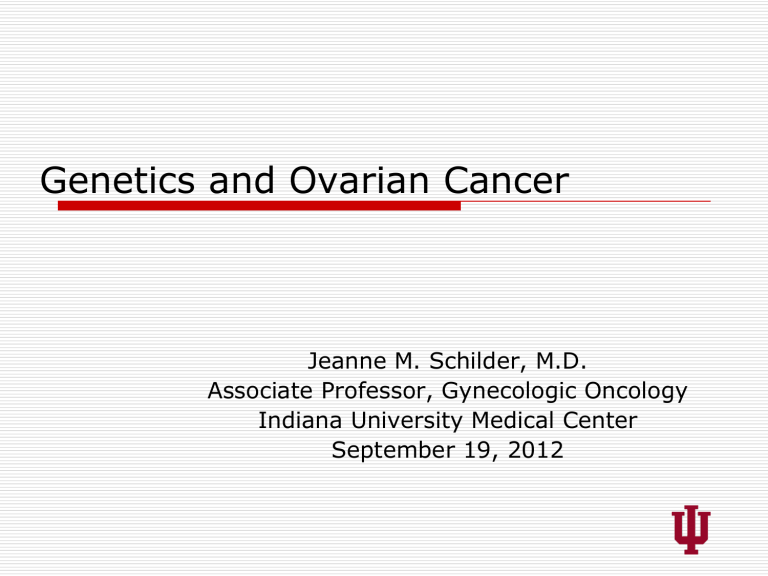
Genetics and Ovarian Cancer
Jeanne M. Schilder, M.D.
Associate Professor, Gynecologic Oncology
Indiana University Medical Center
September 19, 2012
Introduction
Review of ovarian cancer risk factors
What decreases risk?
What increases risk?
What is the role of family history?
What is the role of genetic mutations?
Female Lifetime Risk of Cancer
Ovarian Cancer
General population-1.4%
One first-degree relative-4.2%
Breast Cancer
General population-12.4%
One first-degree relative-24%
Lung Cancer-6.4%
Colon Cancer-4.8%
Endometrial Cancer-2.6%
Ovarian Cancer Risk Factors:
Decreased Risk
Factor
Pregnancies
None
1 full term pregnancy
Relative Risk
1.0
0.6
>5 full term pregnancies 0.29
Use of birth control pills
Never
Ever
3 mo-4 yrs
>10 years
Bilateral Tubal Ligation
Hysterectomy
1.0
0.75
0.6-0.7
0.2
0.5
0.5
Ovarian Cancer Risk Factors:
Increased Risk
Age
25
20
15
10
5
0
45
40
35
30
30 40 50 60 70 80 90+
Cases/100,000
Ovarian Cancer Risk Factors:
Increased Risk
Factor
Hx of Breast Cancer
None
1 st Degree Relative
Personal History
Hx of Ovarian Cancer
None
One 1 st Degree Relative
>2 1 st Degree Relatives
Hereditary Cancer Syndrome
Relative Risk
1.0
2.1
10
1.0
3.1
4-15
12-30
Hereditary Gynecologic Cancer
Syndromes
1. Hereditary Breast/Ovarian Cancer
Syndrome (HBOC)
2. Hereditary Site-Specific Ovarian
Cancer Syndrome
3. Hereditary Nonpolyposis Colon
Cancer Syndrome (HNPCC or Lynch II)
HBOC
~90% of hereditary ovarian cancers
30-70% of hereditary breast cancers
Increased risk of prostate and possibly colon cancer in some HBOC families
Responsible genes: BRCA1, BRCA2
Hereditary Site-Specific Ovarian
Cancer
Variant of HBOC
Families with clusters of ovarian cancer, no breast cancer cases
< 5% of hereditary ovarian cancer cases
Responsible genes: BRCA1, BRCA2
BRCA 1 and BRCA 2 Function
Tumor suppressor genes
Regulate normal cell growth and proliferation
Counteract stimulatory effects of oncogenes
Play a role in DNA repair
Interact with RAD51, a known DNA repair protein
“Caretaker genes”
BRCA Mutation Prevalence:
Populations
General population 0 .125%
(1/800)
Ashkenazi Jewish
Ancestry
2.5%
(1/40)
BRCA Mutation Prevalence:
Personal Cancer History
Breast Cancer
Dx < 50 years
Dx > 50 years
20%
7%
Ovarian Cancer
Both Breast and
Ovarian Cancer
10%
90%
BRCA Mutation Prevalence:
Family Cancer History
Breast Cancer
One 1 st degree relative 3.8%
> 3 relatives 20%
Bilateral 18%
Breast + ovarian cancer 40%
HNPCC or Lynch Syndrome
~7% of hereditary ovarian cancer cases
5% of all colorectal cancer cases
Most common cancers: COLON and
ENDOMETRIAL
Increased incidence of other adenocarcinomas, including stomach, small bowel, and bile duct malignancies ( not breast )
HNPCC
Responsible genes: Mismatch repair genes (MMR) including MLH1, MSH2, and MSH6
Autosomal dominant
Prevalence in the general population:
0.1% (1/1000)
Penetrance by age 70
BRCA 1 and BRCA 2
Ovarian cancer:
Breast cancer:
Male breast cancer:
16-63%
82-87%
6%
HNPCC
Colorectal cancer:
Endometrial cancer:
Stomach cancer:
Ovarian cancer:
68-75%
43-60%
13-19%
9-12%
Second primary: 90%
Most commonly colorectal or endometrial
Red Flags for Hereditary
Cancers
Multiple cases within the family
Autosomal dominant transmission
Early age of onset; earlier in successive generations
Bilateral cancers
Synchronous cancers (> 2 at once)
Metachronous cancers (more than one, diagnosed at different times)
Obtaining a Family History of
Cancer
3-generation family history
1 st Generation : Parents, siblings, children
50% genetic link
2 nd Generation : Grandparents, grandchildren, aunts, uncles, nieces, nephews, ½ siblings
25% genetic link
3 rd Generation : Great-grandparents, greatgrandchildren, great aunts/uncles, grand nieces/nephews, first cousins
12.5% genetic link
Obtaining a Family History of
Cancer
Maternal and paternal data
Include race, ethnic background, current age, all types of cancers, age at diagnosis, age at death
Update at each visit
Confirm with medical records and pathology reports when possible
Elevated HNPCC Risk:
Amsterdam Criteria
1. At least two successive generations with colorectal cancer
2. Diagnosis of at least one individual before age 50
3. Colon cancer in at least 3 relatives
4. Family history of other cancers including ovarian, endometrial, stomach, urinary tract, small bowel, and bile duct
Elevated HNPCC Risk:
Bethesda Criteria
1. Very small families with two cases of colon cancer OR two 1 st degree relatives with colon cancer
AND
2. A third relative with early-onset cancer or endometrial cancer
Identifying Individuals at Risk
Personal and Family History
The most important and cost-effective tool in risk assessment
Risk Factors for BRCA1 and BRCA2
Amsterdam Criteria or Bethesda
Criteria for HNPCC
Gail Model for Breast Cancer Risk
When might genetic testing be considered?
Personal or family hx of pre-menopausal breast cancer AND ovarian cancer (any age)
1 st -degree relative with BRCA1 or 2 mutation
Family hx of > 2 cases of pre-menopausal breast cancer
Family hx of > 2 cases of ovarian cancer
Genetic Testing (con’t)
Personal or family hx of bilateral breast cancer
Family hx of male breast cancer
Ashkenazi Jewish ancestry in the setting of a personal or family hx of breast or ovarian cancer
Clinical Management
Now that you’ve got it, what do you do with it?!
Genetic counseling/testing
Screening
Prophylactic measures/chemoprevention
Consider clinical trials
Possible Outcomes of Genetic
Testing
Definitive
True positive: Deleterious mutation identified
True negative: No mutation, individual from family with a known mutation
Uninformative
No mutation in individual after full gene sequencing, no mutation in family
Mutation of uncertain significance
Risk-Reducing Measures
Prophylactic oophorectomy following completion of child-bearing
Chemoprophylaxis in young patients
Interruption of ovulatory cycles
Oral Contraceptives
OC use for > 5 years reduces risk of ovarian cancer by 60% in the general population
Protective effect increases with increasing duration of use
Protection continues for 10 years following discontinuation
Clinical Trials for Women at
High Risk for Ovarian Cancer
GOG 199
Prospective study of RRSO and longitudinal CA-125
GOG 8199
Extended follow-up of GOG 199 participants
GOG 214
Double-blind randomized trial of levonorgestrel vs. placebo prior to RRSO
Clinical Management of Women with HNPCC: Screening
Annual ultrasound or endometrial biopsy beginning at age 25-35
Hysterectomy and BSO when childbearing complete
Reduces risk of endometrial cancer
Reduces risk of ovarian cancer
Summary
Identifying women at risk for BRCA and HNPCC mutations can often be done in the primary care setting.
Referral is often appropriate.
Genetic counseling
Clinical trials
Long-term follow-up
Screening and/or prophylaxis can be life saving.
Acknowledgments
Melissa Ade
In The Family, a film by Joanna
Rudnick
Screening privileges/copyright privileges obtained from Kartemquin Films, Chicago
www.inthefamilyfilm.com
